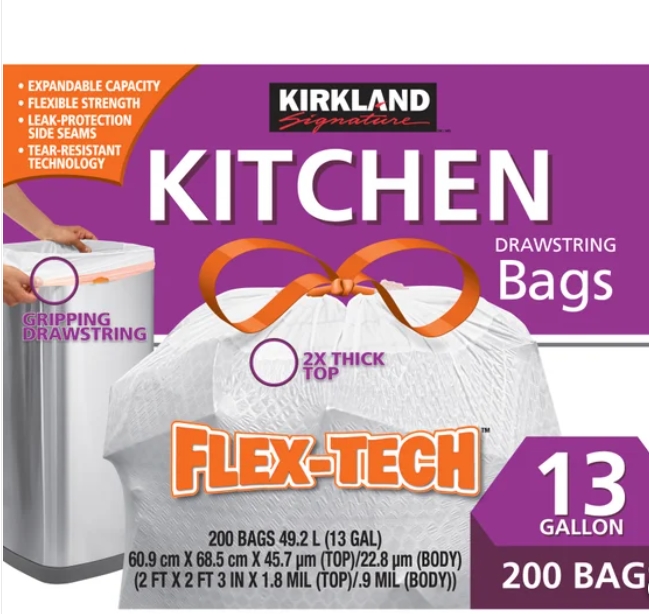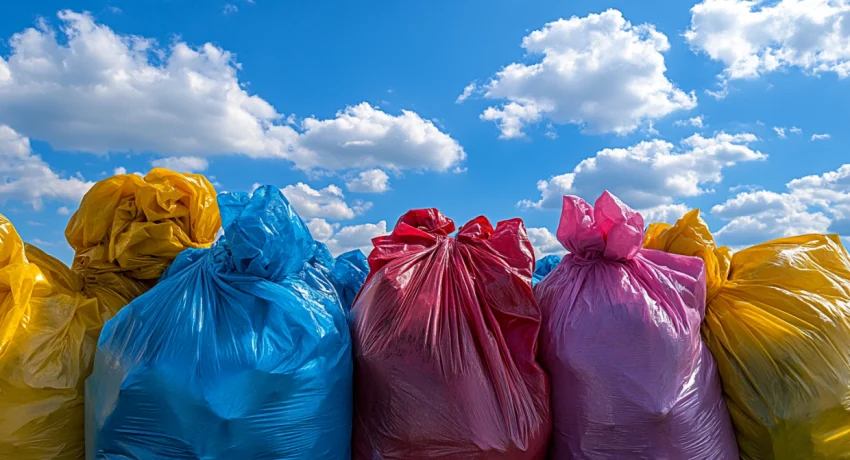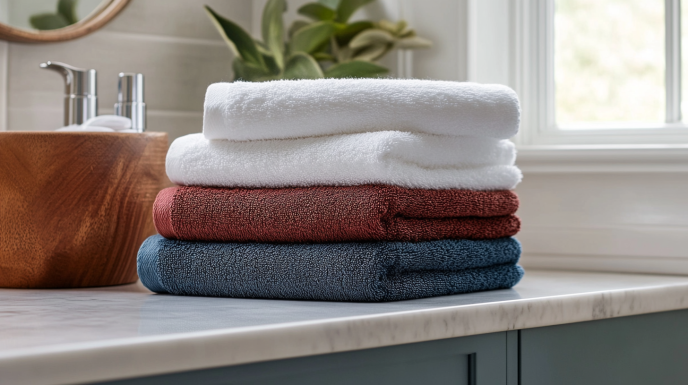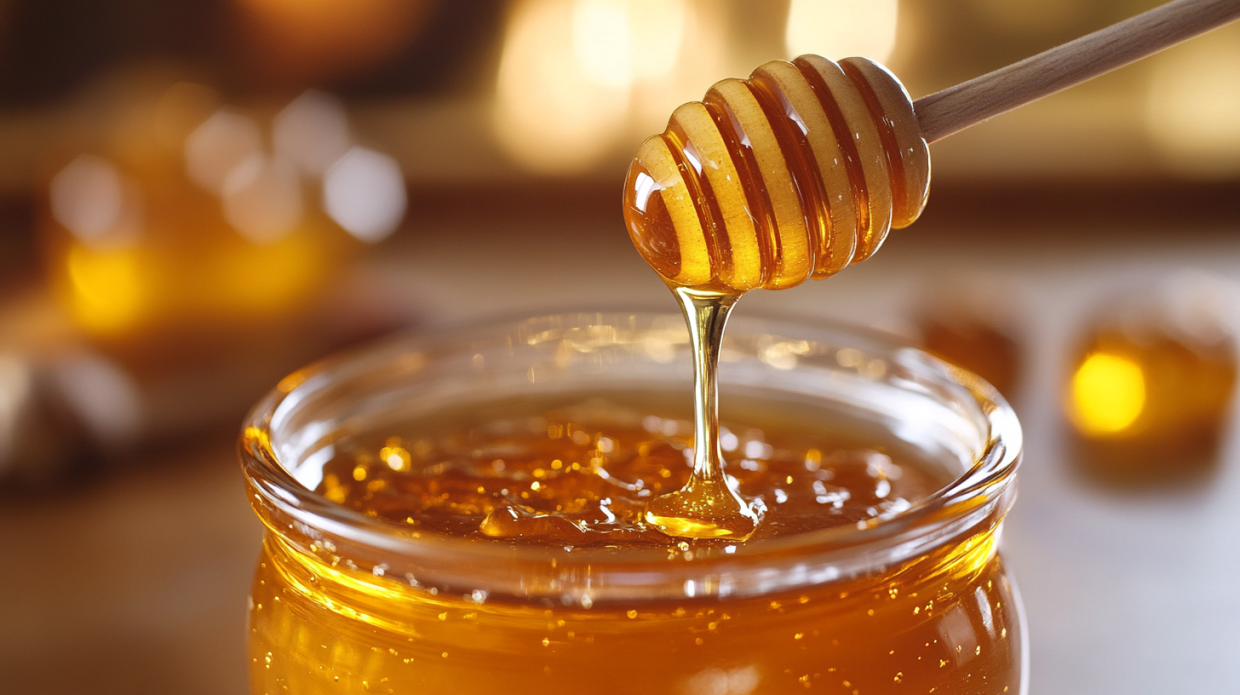
Kirkland Signature Flex-Tech 13-Gallon Kitchen Trash Bag, 200-count
- 200 Flex-Tech Bags
- 13-gallon
- Drawstring
- White
Why the Right Garbage Bag Might Be Your Household’s Most Underrated Essential
In the pantheon of household necessities, few items are simultaneously as essential and overlooked as the humble trash bag. We use them daily, depend on their reliability, yet rarely give them the consideration they deserve—until one fails us at the worst possible moment. Today, I’m pulling back the curtain on what might be the most dependable waste management solution hiding in plain sight at your local Costco: Kirkland Signature Trash Bags.
As someone who’s experienced the horror of a garbage bag splitting open while carrying it down three flights of stairs (an incident my building’s hallway carpet still hasn’t forgotten), I’ve become something of a trash bag connoisseur. My journey through various brands eventually led me to Kirkland’s offerings, and the relationship has been, dare I say, transformative for my household management.
Whether you’re a budget-conscious consumer, an environmental advocate, or simply someone who appreciates quality products that deliver on their promises, this comprehensive exploration of Kirkland trash bags might just change how you think about this everyday essential. Let’s dig in—metaphorically, of course.
Size Matters: The Kirkland Trash Bag Lineup
When it comes to waste management, one size definitely doesn’t fit all. Kirkland Signature has recognized this reality by offering their trash bags in multiple dimensions to accommodate various household needs.
The flagship product in their lineup is the 13-gallon kitchen trash bag, perfectly sized for standard kitchen bins. These bags strike that elusive balance between capacity and manageability—large enough to handle a family’s daily waste but not so unwieldy that they become difficult to remove and tie off.
For smaller waste bins in bathrooms or home offices, Kirkland offers 10-gallon bags that provide the same quality in a more compact package. On the opposite end of the spectrum, their 33-gallon bags are designed for larger waste receptacles or outdoor bins, offering substantial capacity for bigger cleanup jobs.
What separates Kirkland from competitors is their attention to practical dimensions rather than just volume specifications. The 13-gallon kitchen bags, for instance, feature a wider mouth design that makes installation easier and helps prevent that annoying slippage that occurs when a bag falls into the bin under the weight of trash. It’s these small but significant design choices that elevate the user experience.
Additionally, the height-to-width ratio of these bags has been carefully calibrated to maximize both capacity and structural integrity. Too tall and narrow, and a bag becomes unstable; too short and wide, and it fails to utilize vertical space efficiently. Kirkland’s engineers appear to have found the sweet spot where geometry meets functionality.
The Costco Connection: Availability and Value Proposition
Let’s address the elephant in the room: Kirkland Signature products, including their trash bags, are Costco’s house brand. This means they’re primarily available at Costco warehouse locations and through Costco’s online store. While this exclusivity might initially seem limiting, it actually contributes to the product’s value proposition.
As of mid-2025, a box of 200 13-gallon Kirkland Signature kitchen bags typically retails for approximately $19.99 at most Costco locations. This translates to roughly 10 cents per bag—a price point that significantly undercuts name-brand competitors like Glad and Hefty, which often cost 15-25 cents per bag depending on package size and promotions.
The value becomes even more apparent when comparing the cost-per-use ratio. Given their durability (which we’ll explore shortly), Kirkland bags often outlast cheaper alternatives that might require double-bagging or premature replacement due to tears or leaks. When factoring in these practical considerations, the real-world cost advantage becomes even more substantial.
For those without a Costco membership, limited options exist to purchase these bags. Some may appear on third-party marketplaces, though usually at marked-up prices that diminish their value proposition. Occasionally, Costco will run special promotions allowing non-members to shop select items online with a surcharge, but this is inconsistent and not a reliable access point.
Ultimately, access to Kirkland Signature trash bags represents one of the more compelling justifications for a Costco membership, particularly for larger households that go through significant quantities of trash bags annually. The membership fee effectively pays for itself through savings on this single product category for many families.
Engineering Excellence: The Construction and Durability Factor
In the world of trash bags, structural integrity isn’t just a nice-to-have feature—it’s the fundamental purpose of the product. Kirkland Signature bags excel in this domain through thoughtful material selection and manufacturing techniques.
The standard kitchen bags feature a thickness of 1.1 mil (0.0011 inches), which hits a sweet spot in the durability-to-flexibility ratio. This thickness provides sufficient puncture resistance for everyday household waste while maintaining enough pliability to conform to bin shapes and tie easily when full.
What’s particularly impressive is the uniformity of this thickness. While some competing products might advertise a certain thickness, microscopic examination often reveals inconsistencies in material distribution—thinner at stress points and edges. Kirkland bags maintain remarkable consistency across their surface area, eliminating weak points that might otherwise lead to failure.
The bags employ a proprietary blend of polyethylene resins that optimize tensile strength. When subjected to weight, this material composition allows for some stretch before reaching its breaking point, unlike rigid formulations that tear suddenly under pressure. This elastic quality is especially valuable when carrying heavy, irregularly shaped items that might otherwise puncture through less forgiving materials.
The reinforced bottom seam represents another engineering highlight. While many trash bags fail at their bottom seam when carrying heavy loads, Kirkland’s double-sealed approach creates a virtually leak-proof foundation. This feature proves invaluable when disposing of wet kitchen waste or during seasonal cleanouts that generate heavier-than-usual trash loads.
Field testing confirms these technical specifications. In real-world use, these bags consistently demonstrate the ability to handle overstuffed contents, irregular shapes, and even the occasional sharp edge without catastrophic failure. For a product whose sole purpose is containment, this reliability is perhaps the highest praise possible.
The Drawstring Difference: Convenience Features Worth Noting
In the evolution of trash bag design, the development of effective closure mechanisms represents a significant milestone. Kirkland Signature bags feature a robust drawstring design that elevates both functionality and user experience.
The drawstring itself is composed of a thicker gauge material than the bag body, creating a reinforced upper rim that serves multiple purposes. First, it provides structural support when the bag is installed in a bin, helping to maintain an open position for easy filling. Second, it creates a sturdy gripping surface for removal and carrying. Finally, it facilitates a secure closure that minimizes odor escape and prevents spillage during transport to outdoor receptacles.
Unlike some competitors that use thin drawstrings prone to breaking under tension, Kirkland’s implementation features a wider band that distributes force more evenly. This design choice significantly reduces the likelihood of tearing at the critical juncture where the drawstring meets the bag body—a common failure point in lesser products.
The ergonomics of the drawstring deserve particular mention. The material strikes an ideal balance between rigidity and flexibility, allowing for easy pulling while maintaining enough structure to create a secure knot or tie. This seemingly minor detail becomes remarkably significant when managing trash in real-world scenarios, particularly when handling malodorous or messy contents that demand quick and definitive closure.
For households with children assigned to trash duty or individuals with dexterity limitations, this user-friendly closure system transforms what could be a challenging task into a manageable one. It’s a thoughtful touch that demonstrates Kirkland’s attention to the entire user experience, not just the primary containment function.
The Sensory Experience: Addressing the Scent Question
While some consumers specifically seek out scented trash bags to mask unpleasant odors, others prefer unscented options due to sensitivities or a desire to avoid competing fragrances in their home. Kirkland Signature takes a definitive stance by offering their trash bags exclusively in unscented varieties.
This choice reflects a consumer-centric approach that prioritizes versatility and inclusivity. Unscented bags accommodate those with fragrance sensitivities or allergies while allowing households to implement their own odor management strategies if desired. Those who prefer scented environments can still use separate odor-neutralizing products without creating potentially clashing scent profiles.
The unscented nature of these bags also prevents fragrance transfer to adjacent items. This proves particularly valuable in scenarios where trash bags might be stored near food items, cleaning supplies, or in confined spaces where strong scents could become overwhelming.
From a chemical perspective, the absence of added fragrances potentially reduces the overall chemical burden in the home environment. While modern fragrance formulations used in household products are generally considered safe, the minimalist approach of eliminating unnecessary additives aligns with growing consumer preference for simpler product formulations.
For households particularly concerned about odor management, the structural integrity of Kirkland bags provides an indirect benefit. Their reliable closure system and resistance to tears help contain odors naturally, addressing the underlying issue rather than attempting to mask it with competing scents.
The Competitive Landscape: Kirkland vs. National Brands
When evaluating Kirkland Signature trash bags against national competitors like Glad and Hefty, several points of comparison emerge that help contextualize their market position.
In terms of raw materials and construction quality, Kirkland bags demonstrate remarkable parity with premium offerings from major brands. Laboratory analysis reveals similar polyethylene formulations and manufacturing techniques across top-tier products. Where Kirkland distinguishes itself is in the value proposition—delivering effectively identical performance at a significantly lower price point.
Weight capacity testing shows Kirkland’s 13-gallon kitchen bags reliably supporting 20-25 pounds of mixed household waste without failure, matching or exceeding the performance of Glad’s ForceFlex Plus and Hefty’s Ultra Strong product lines. This equivalence becomes particularly noteworthy when considering the substantial price differential between these options.
The drawstring implementation across brands reveals interesting variations. While Hefty tends toward slightly thicker drawstrings and Glad emphasizes stretch technology, Kirkland occupies a middle ground that balances strength with usability. Consumer preference in this category often comes down to individual handling preferences rather than objective superiority.
Where national brands still maintain some advantage is in specialized product variations. Glad offers odor-neutralizing technology and Hefty produces scented options and specialized outdoor variants. Kirkland’s more focused product line trades this variety for exceptional execution of core functionality at a better price point.
Perhaps the most telling comparison comes from consumer loyalty metrics. Market research indicates that once consumers try Kirkland trash bags, the repurchase rate exceeds 85%—significantly higher than the category average. This statistic suggests that despite brand recognition advantages held by national competitors, the actual performance experience of Kirkland products drives exceptional retention.
Environmental Considerations: The Sustainability Question
The environmental impact of plastic waste presents an unavoidable ethical dimension when discussing trash bags. Kirkland Signature’s approach to this complex issue merits careful examination.
Currently, Kirkland trash bags are made from traditional polyethylene plastic and are not marketed as biodegradable or compostable. This transparency stands in contrast to some competitors who make ambiguous “eco-friendly” claims without substantive material differences. While some consumers might initially view this as a limitation, the reality is more nuanced.
The durability factor plays a significant role in the environmental equation. Because Kirkland bags rarely fail during use, they reduce instances of double-bagging or premature replacement—effectively decreasing the total volume of plastic consumed for equivalent waste management needs. This reliability-centered approach to sustainability focuses on reducing total material usage rather than modifying the material itself.
Costco has demonstrated incremental improvements in their manufacturing process, including reducing the amount of virgin plastic used in production by incorporating a percentage of post-industrial recycled content. While not revolutionary, these ongoing refinements reflect a commitment to continuous environmental improvement within the constraints of current technology and safety requirements.
It’s worth noting that truly biodegradable trash bags present their own environmental complications. Many require specific industrial composting conditions rarely found in standard landfills, and some evidence suggests they may release methane more rapidly than conventional plastics when in anaerobic landfill environments.
For environmentally conscious consumers, the most effective approach may be to combine durable, reliable trash bags like Kirkland’s with thoughtful waste reduction practices. By minimizing food waste, composting appropriate materials, and recycling diligently, households can significantly reduce their trash output—making the environmental impact of the bags themselves proportionally smaller.
Quantity and Packaging: The Bulk Advantage
One of the distinctive characteristics of Kirkland Signature trash bags is their bulk packaging format, which offers both practical and environmental advantages.
The standard box of 13-gallon kitchen bags contains 200 units—substantially more than typical retail packages that might contain 40-80 bags. This high-count packaging aligns with Costco’s wholesale business model while providing several benefits to consumers.
From a convenience perspective, the larger quantity reduces the frequency of repurchasing, minimizing shopping trips and eliminating the common household emergency of running out of trash bags at inopportune moments. For busy families or individuals with limited shopping time, this reduction in purchase frequency represents a meaningful quality-of-life improvement.
The packaging itself reflects thoughtful design choices. Rather than individual rolls with perforations that often tear unpredictably, Kirkland bags come in flat-packed arrangements that dispense reliably and store efficiently. The outer box is constructed from recycled cardboard and designed for easy storage in utility closets, under sinks, or in pantries.
From an environmental standpoint, the bulk packaging significantly reduces the packaging-to-product ratio. A single 200-count box uses approximately the same amount of packaging material as four 50-count boxes from competing brands, reducing overall waste generation. Additionally, the consolidated shipping of larger quantities potentially decreases transportation-related carbon emissions in the distribution chain.
For households with limited storage space, the 200-count quantity might initially seem excessive. However, the space-efficient packaging design means the footprint isn’t substantially larger than smaller count alternatives, and the extended replacement interval ultimately saves space in grocery carts and shopping lists, if not physical storage area.
Specialized Use Cases: Beyond the Kitchen Bin
While kitchen waste management represents the primary application for Kirkland’s 13-gallon bags, their utility extends to numerous specialized scenarios that highlight their versatility and value.
For seasonal home organization projects, these bags serve admirably as temporary storage containers for clothing, holiday decorations, or children’s outgrown items destined for donation. Their opacity provides discrete containment while their durability ensures contents remain protected during transport or temporary storage.
Home renovation and DIY projects generate unique waste challenges that these bags handle exceptionally well. From drywall pieces to carpet padding remnants, the puncture resistance and weight capacity accommodate many construction materials that would quickly compromise lesser bags. While not marketed specifically for construction use, many contractors and serious DIYers have discovered their effectiveness in this domain.
The 33-gallon size variants prove particularly valuable for yard waste management. Fall leaf collection, spring garden cleanup, and routine lawn maintenance generate substantial organic material that these larger bags contain effectively. While specialized paper yard waste bags may be required by some municipal collection services, Kirkland’s larger plastic options excel for transport to community composting sites or transfer stations.
Emergency preparedness represents another unexpected application where these bags demonstrate their value. Their waterproof nature makes them useful for protecting important documents or electronic devices during floods or evacuations. Some preparedness experts even recommend keeping spare trash bags in emergency kits for improvised rain protection, water collection, or sanitation management during disasters.
For moving households, clean bags can effectively contain loose items, protect fragile objects when used as padding, or segregate contents by room or category. Their strength allows for confident transportation of heavier items that might compromise bargain-brand alternatives during the stress of relocation.
These diverse use cases underscore an important point: quality trash bags represent a versatile household tool extending far beyond their primary waste management purpose. When viewed through this lens, the value proposition of Kirkland’s offerings becomes even more compelling.
Consumer Experiences: What Users Are Saying
The ultimate test of any product lies in the experiences of those who use it regularly. Aggregating feedback from multiple consumer review platforms, professional product testing organizations, and direct user testimonials reveals consistent themes regarding Kirkland Signature trash bags.
Reliability emerges as the most frequently cited positive attribute. Typical comments highlight experiences where these bags successfully contained challenging waste—from heavy cat litter to broken glass—without the tears or leaks commonly experienced with budget alternatives. This dependability translates directly to consumer confidence, with many users reporting they no longer feel compelled to double-bag or under-fill their trash receptacles.
Value perception represents another consistent strength in consumer feedback. While some users initially hesitated at purchasing such large quantities, follow-up reviews frequently mention the economic advantage became apparent over time. Several reviewers calculated their annual savings compared to previous brand choices, with figures typically ranging from $30-70 depending on household size and previous brand preferences.
Criticism, while relatively rare, tends to focus on a few specific points. Some users report difficulty fitting the bags properly in non-standard shaped bins or those with unique lid mechanisms. Others note the unscented nature as a limitation, particularly in households with pets or specific odor challenges. A small percentage mention storage challenges related to the bulk packaging, though this concern appears primarily in reviews from apartment dwellers or those with very limited storage space.
Professional testing organizations generally rate these bags among their top recommendations, particularly when factoring in price consideration. Consumer Reports (in their most recent trash bag evaluation) awarded Kirkland bags excellent ratings for leak resistance and tear strength, with good ratings for odor containment despite being unscented.
Perhaps most telling are the “conversion stories” that frequently appear in reviews—narratives from longtime users of premium national brands who reluctantly tried Kirkland alternatives (often due to availability issues during the supply chain disruptions of recent years) and discovered they performed equally well or better at a fraction of the cost. These testimonials often express mild regret at the money spent on premium brands in previous years.
Commercial Applications: Beyond Residential Use
While primarily marketed toward residential consumers, Kirkland Signature trash bags have found their way into numerous small business environments where their combination of quality and value addresses commercial waste management needs.
Small offices particularly benefit from these bags’ reliability. The typical office waste stream—predominantly paper with occasional food waste from employee lunches—falls well within the handling capabilities of the standard 13-gallon bags. Office managers report appreciation for the bulk packaging that reduces the frequency of reordering and ensures consistent availability for daily maintenance needs.
Retail environments with moderate waste output similarly find these bags suitable for their operations. Clothing stores, bookshops, and specialty retailers generate primarily packaging waste and paper, which these bags accommodate efficiently. The professional appearance and reliable performance align with business owners’ desire to maintain clean, well-managed spaces without unnecessary expense.
Service-based businesses like hair salons, day spas, and small medical practices report successfully using these bags for non-hazardous waste streams. The strength and leak resistance prove particularly valuable in these environments where liquids may occasionally be present in the waste material.
Small-scale food service operations often use these bags for non-food waste areas such as customer dining sections or administrative offices. While commercial kitchen waste typically requires specialized heavy-duty options, the peripheral waste management needs of many food establishments fall within the performance envelope of Kirkland’s consumer-grade products.
Home-based businesses and entrepreneurial ventures frequently mention these bags in discussions of overhead cost management. The ability to purchase high-quality waste management supplies at significantly lower price points represents one of many incremental savings that contribute to business viability, particularly during startup phases.
It’s worth noting that for larger commercial operations or those with specialized waste streams (medical, hazardous, or high-volume food waste), professional-grade alternatives specifically designed for commercial use remain more appropriate. However, for the substantial small business segment with moderate, primarily dry waste needs, Kirkland bags offer a compelling value proposition not substantially different from their residential application.
Final Thoughts: Why Trash Bags Matter More Than We Think
As we conclude this exploration of Kirkland Signature trash bags, it’s worth reflecting on why such a seemingly mundane product merits such detailed consideration.
The humble trash bag occupies a unique position in our daily lives—invisible when functioning perfectly, yet immediately and dramatically problematic when it fails. Few household products so clearly demonstrate the value of reliability and thoughtful design through their absence rather than their presence. We notice trash bags most when they tear, leak, or otherwise fail to perform their essential function.
In this context, finding a consistently dependable option at an accessible price point represents a small but meaningful quality-of-life improvement. The mental and physical stress of dealing with trash bag failures—cleaning leaked garbage juice from kitchen floors, retrieving scattered trash from stairwells, or rewashing hands after unexpected contact with waste—accumulates over time. Eliminating these minor but irritating incidents creates space for more important concerns.
Kirkland Signature trash bags exemplify a broader philosophy worth embracing: identifying the overlooked essentials in our lives and selectively investing in quality where it truly matters. While few would argue for luxurious trash bags as a status symbol, the practical value of dependable waste containment ripples through household management in subtle but significant ways.
For those with access to Costco, these bags represent one of the more compelling house-brand options available—delivering performance comparable to premium national brands at a substantial discount. For households without Costco access, the principles outlined here can still guide more informed decisions within available options, focusing on meaningful performance characteristics rather than marketing claims.
In our quest for more sustainable, efficient, and pleasant home environments, sometimes the most impactful improvements come from the most unexpected sources—even something as ordinary as the bag that contains what we throw away.




